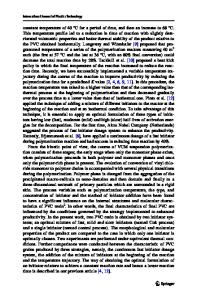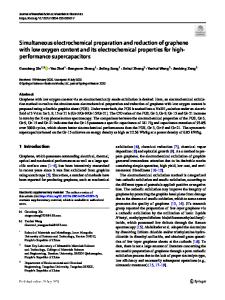The electrochemical property of acetylene black suspension solution with ozone bubbling and its effects on copper dissol
- PDF / 224,180 Bytes
- 7 Pages / 612 x 792 pts (letter) Page_size
- 51 Downloads / 296 Views
I. INTRODUCTION
A great amount of attention has been paid to the surface peculiarity of carbon as an electrode material. It has been described as a collection of organic functional groups containing oxygen.[1,2] It is well known that the surface functional groups such as hydroquinone, carbony, carboxyl, and lactone occur in the activated process on the developed surface of carbon materials.[3,4] A great deal of research into the mechanism of the interaction of various carbon materials and electrolyte solutions has shown that these surface functional groups and physically adsorbed gases (especially O2) significantly affect the electrochemical properties of carbon materials.[5] Because the redox reaction of the surface functional groups can occur and gases can adsorb on the carbon material,[6] carbon particles are expected to act as a redox reaction site on which electrochemical reactions will take place. On the other hand, ozone, as a strong oxidant with a very high oxidation potential that is inferior only to fluorine, can react directly with many organic or inorganic substances.[7] A great deal of research has been carried out on the application of ozone to the purification of air and potable water, and to the disinfection of food and waste water, as well as its use as an oxidant or modifier in metallic and chemical industries. In fact, ozone has been used as a commercial DAWEI WEI, Postdoctor, RYOICHI ICHINO, Lecturer, and MASAZUMI OKIDO, Professor, are with the Division of Materials Science, Center for Integrated Research in Science and Engineering, Nagoya University, Nagoya 464-8601, Japan. SHINICHIRO KATO, formerly Graduate Student, Graduate School of of Engineering, Nagoya University, is Engineer with Daido Steel Company, Nagoya 457-8545, Japan. Manuscript submitted December 16, 1998. METALLURGICAL AND MATERIALS TRANSACTIONS B
water disinfectant for over 90 years. In the hydrometallurgical processing, ozone is also applied to the direct extraction of UO2,[8] MnO2,[9] BaO,[10] and nickel-cobalt separation.[11] Potable water treatment has been conducted by a method in which granular activated carbon is combined with ozone bubbling, because ozone can react with carbonaceous materials to yield surface oxides even to carbon dioxide.[12] Thus, the combined use of ozone and carbon materials in the metal leaching process may be a promising method for high-speed metal leaching, considering the oxidative power of ozone combined with the activity of acetylene black particles. Especially, the application of technology such as the combined use of ozone and carbon materials in hydrometallurgy appears to be very promising to the environment-protection climate of the 1990s, because these materials and their side products have less impact upon the environment. As a result, at first, the electrochemical properties of an acetylene black suspension solution with ozone-containing air bubbling are evaluated by a potentiometric method in this study. The process of copper dissolution in the acetylene black suspension solution with
Data Loading...











